Crime Prevention and Media Intervention
VerifiedAdded on 2019/11/26
|7
|1375
|184
Essay
AI Summary
This essay examines crime prevention strategies, emphasizing the roles of media and police. It discusses situational and social crime prevention, highlighting programs like youth diversion and family interventions. The essay analyzes the impact of media campaigns in raising public awareness and shaping behavior related to safety. A case study of police intervention in a crime situation is presented, illustrating the effectiveness of combined media and police efforts. The role of government policies and legislation in crime prevention is also explored, referencing specific acts and their impact on crime rates. The essay concludes by summarizing the importance of integrated approaches involving government, media, and police in achieving effective crime prevention and mitigation.
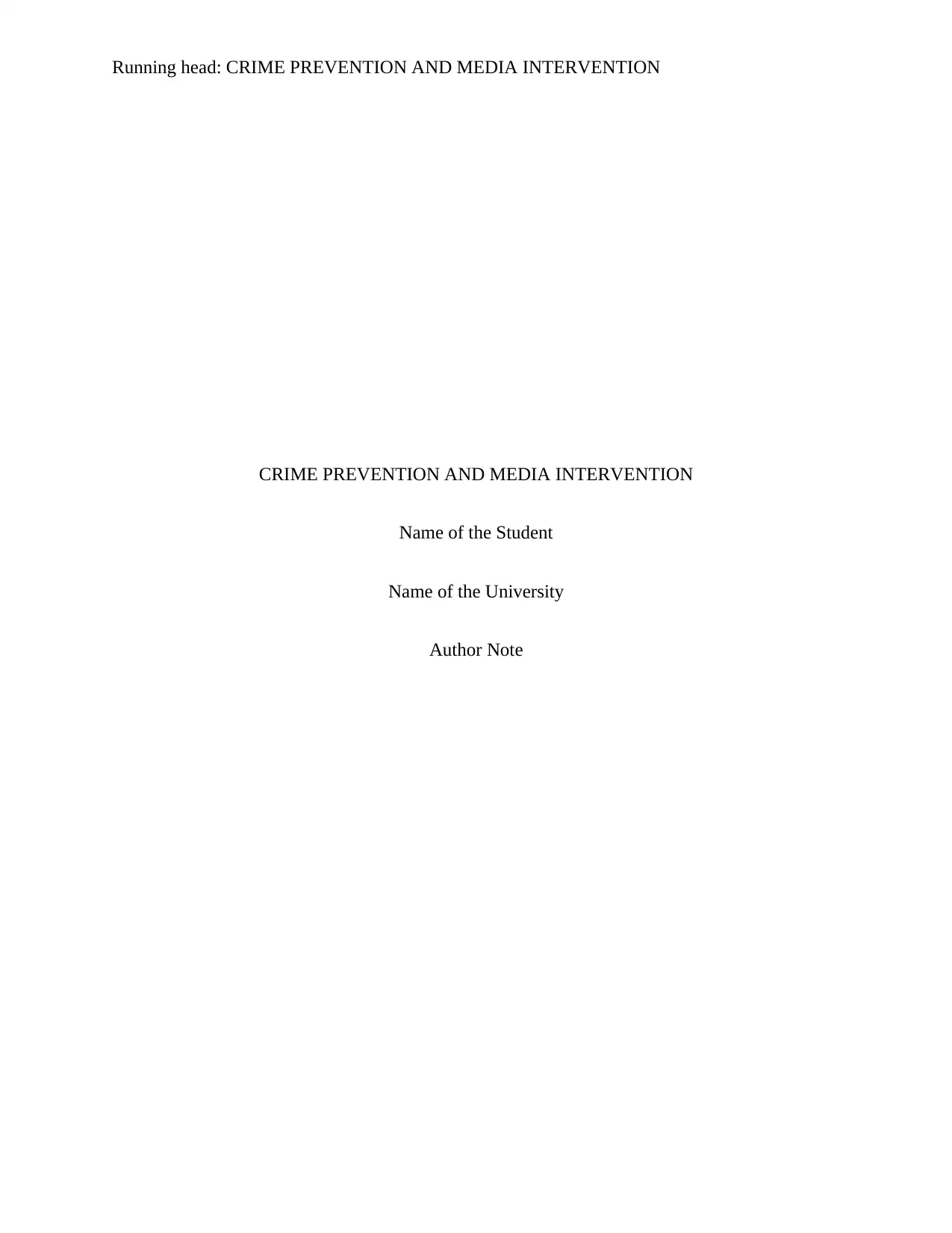
Running head: CRIME PREVENTION AND MEDIA INTERVENTION
CRIME PREVENTION AND MEDIA INTERVENTION
Name of the Student
Name of the University
Author Note
CRIME PREVENTION AND MEDIA INTERVENTION
Name of the Student
Name of the University
Author Note
Paraphrase This Document
Need a fresh take? Get an instant paraphrase of this document with our AI Paraphraser
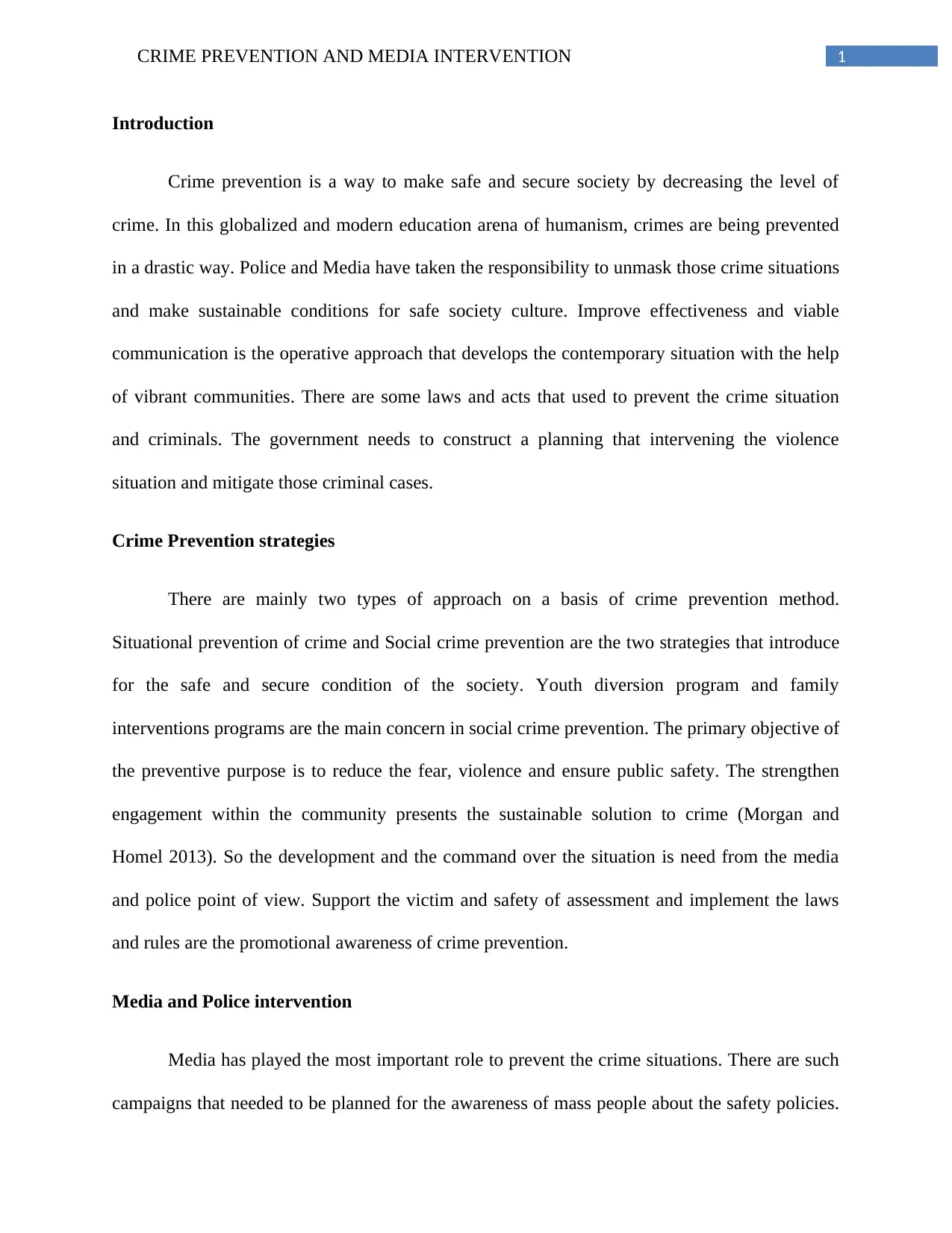
1CRIME PREVENTION AND MEDIA INTERVENTION
Introduction
Crime prevention is a way to make safe and secure society by decreasing the level of
crime. In this globalized and modern education arena of humanism, crimes are being prevented
in a drastic way. Police and Media have taken the responsibility to unmask those crime situations
and make sustainable conditions for safe society culture. Improve effectiveness and viable
communication is the operative approach that develops the contemporary situation with the help
of vibrant communities. There are some laws and acts that used to prevent the crime situation
and criminals. The government needs to construct a planning that intervening the violence
situation and mitigate those criminal cases.
Crime Prevention strategies
There are mainly two types of approach on a basis of crime prevention method.
Situational prevention of crime and Social crime prevention are the two strategies that introduce
for the safe and secure condition of the society. Youth diversion program and family
interventions programs are the main concern in social crime prevention. The primary objective of
the preventive purpose is to reduce the fear, violence and ensure public safety. The strengthen
engagement within the community presents the sustainable solution to crime (Morgan and
Homel 2013). So the development and the command over the situation is need from the media
and police point of view. Support the victim and safety of assessment and implement the laws
and rules are the promotional awareness of crime prevention.
Media and Police intervention
Media has played the most important role to prevent the crime situations. There are such
campaigns that needed to be planned for the awareness of mass people about the safety policies.
Introduction
Crime prevention is a way to make safe and secure society by decreasing the level of
crime. In this globalized and modern education arena of humanism, crimes are being prevented
in a drastic way. Police and Media have taken the responsibility to unmask those crime situations
and make sustainable conditions for safe society culture. Improve effectiveness and viable
communication is the operative approach that develops the contemporary situation with the help
of vibrant communities. There are some laws and acts that used to prevent the crime situation
and criminals. The government needs to construct a planning that intervening the violence
situation and mitigate those criminal cases.
Crime Prevention strategies
There are mainly two types of approach on a basis of crime prevention method.
Situational prevention of crime and Social crime prevention are the two strategies that introduce
for the safe and secure condition of the society. Youth diversion program and family
interventions programs are the main concern in social crime prevention. The primary objective of
the preventive purpose is to reduce the fear, violence and ensure public safety. The strengthen
engagement within the community presents the sustainable solution to crime (Morgan and
Homel 2013). So the development and the command over the situation is need from the media
and police point of view. Support the victim and safety of assessment and implement the laws
and rules are the promotional awareness of crime prevention.
Media and Police intervention
Media has played the most important role to prevent the crime situations. There are such
campaigns that needed to be planned for the awareness of mass people about the safety policies.
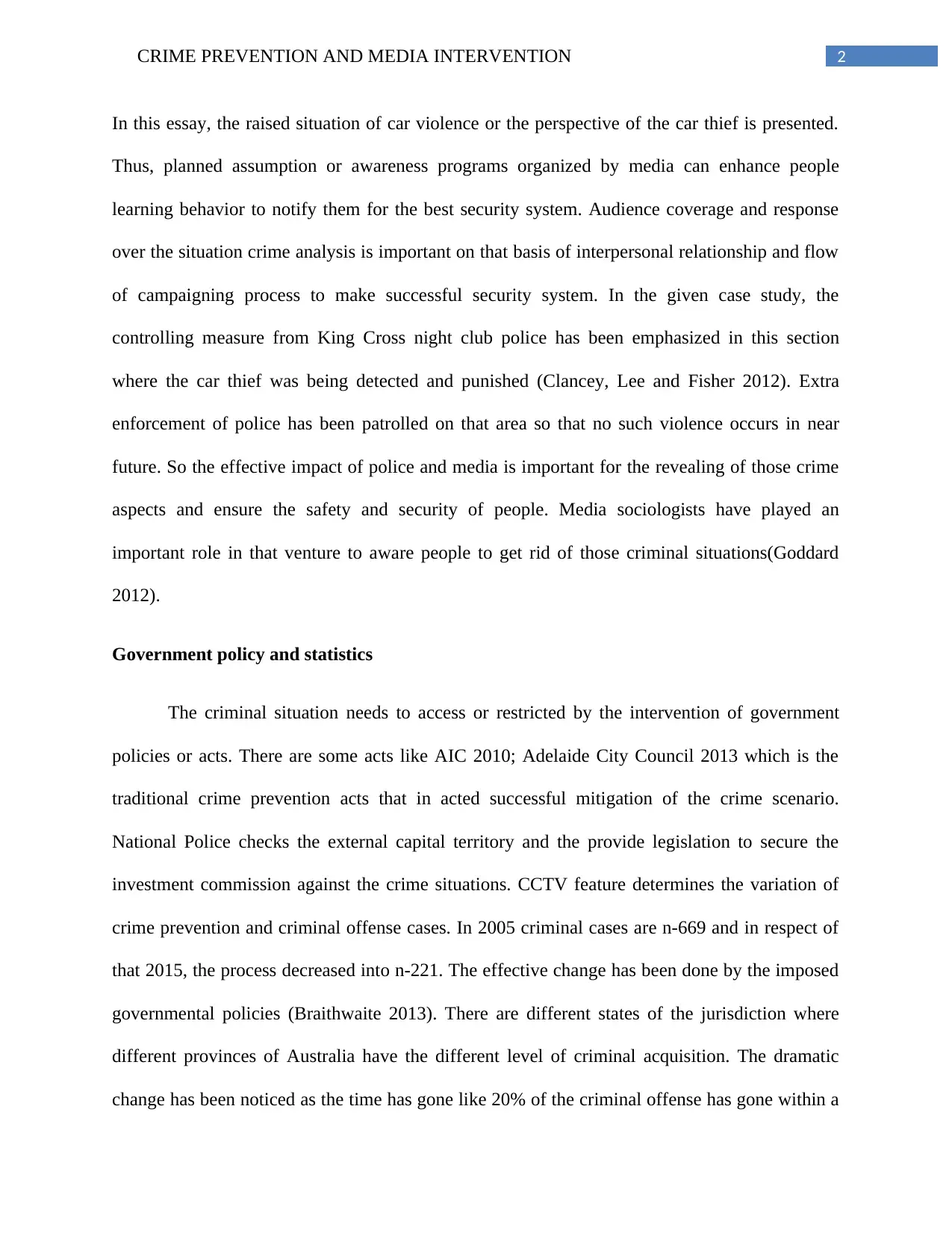
2CRIME PREVENTION AND MEDIA INTERVENTION
In this essay, the raised situation of car violence or the perspective of the car thief is presented.
Thus, planned assumption or awareness programs organized by media can enhance people
learning behavior to notify them for the best security system. Audience coverage and response
over the situation crime analysis is important on that basis of interpersonal relationship and flow
of campaigning process to make successful security system. In the given case study, the
controlling measure from King Cross night club police has been emphasized in this section
where the car thief was being detected and punished (Clancey, Lee and Fisher 2012). Extra
enforcement of police has been patrolled on that area so that no such violence occurs in near
future. So the effective impact of police and media is important for the revealing of those crime
aspects and ensure the safety and security of people. Media sociologists have played an
important role in that venture to aware people to get rid of those criminal situations(Goddard
2012).
Government policy and statistics
The criminal situation needs to access or restricted by the intervention of government
policies or acts. There are some acts like AIC 2010; Adelaide City Council 2013 which is the
traditional crime prevention acts that in acted successful mitigation of the crime scenario.
National Police checks the external capital territory and the provide legislation to secure the
investment commission against the crime situations. CCTV feature determines the variation of
crime prevention and criminal offense cases. In 2005 criminal cases are n-669 and in respect of
that 2015, the process decreased into n-221. The effective change has been done by the imposed
governmental policies (Braithwaite 2013). There are different states of the jurisdiction where
different provinces of Australia have the different level of criminal acquisition. The dramatic
change has been noticed as the time has gone like 20% of the criminal offense has gone within a
In this essay, the raised situation of car violence or the perspective of the car thief is presented.
Thus, planned assumption or awareness programs organized by media can enhance people
learning behavior to notify them for the best security system. Audience coverage and response
over the situation crime analysis is important on that basis of interpersonal relationship and flow
of campaigning process to make successful security system. In the given case study, the
controlling measure from King Cross night club police has been emphasized in this section
where the car thief was being detected and punished (Clancey, Lee and Fisher 2012). Extra
enforcement of police has been patrolled on that area so that no such violence occurs in near
future. So the effective impact of police and media is important for the revealing of those crime
aspects and ensure the safety and security of people. Media sociologists have played an
important role in that venture to aware people to get rid of those criminal situations(Goddard
2012).
Government policy and statistics
The criminal situation needs to access or restricted by the intervention of government
policies or acts. There are some acts like AIC 2010; Adelaide City Council 2013 which is the
traditional crime prevention acts that in acted successful mitigation of the crime scenario.
National Police checks the external capital territory and the provide legislation to secure the
investment commission against the crime situations. CCTV feature determines the variation of
crime prevention and criminal offense cases. In 2005 criminal cases are n-669 and in respect of
that 2015, the process decreased into n-221. The effective change has been done by the imposed
governmental policies (Braithwaite 2013). There are different states of the jurisdiction where
different provinces of Australia have the different level of criminal acquisition. The dramatic
change has been noticed as the time has gone like 20% of the criminal offense has gone within a
⊘ This is a preview!⊘
Do you want full access?
Subscribe today to unlock all pages.

Trusted by 1+ million students worldwide
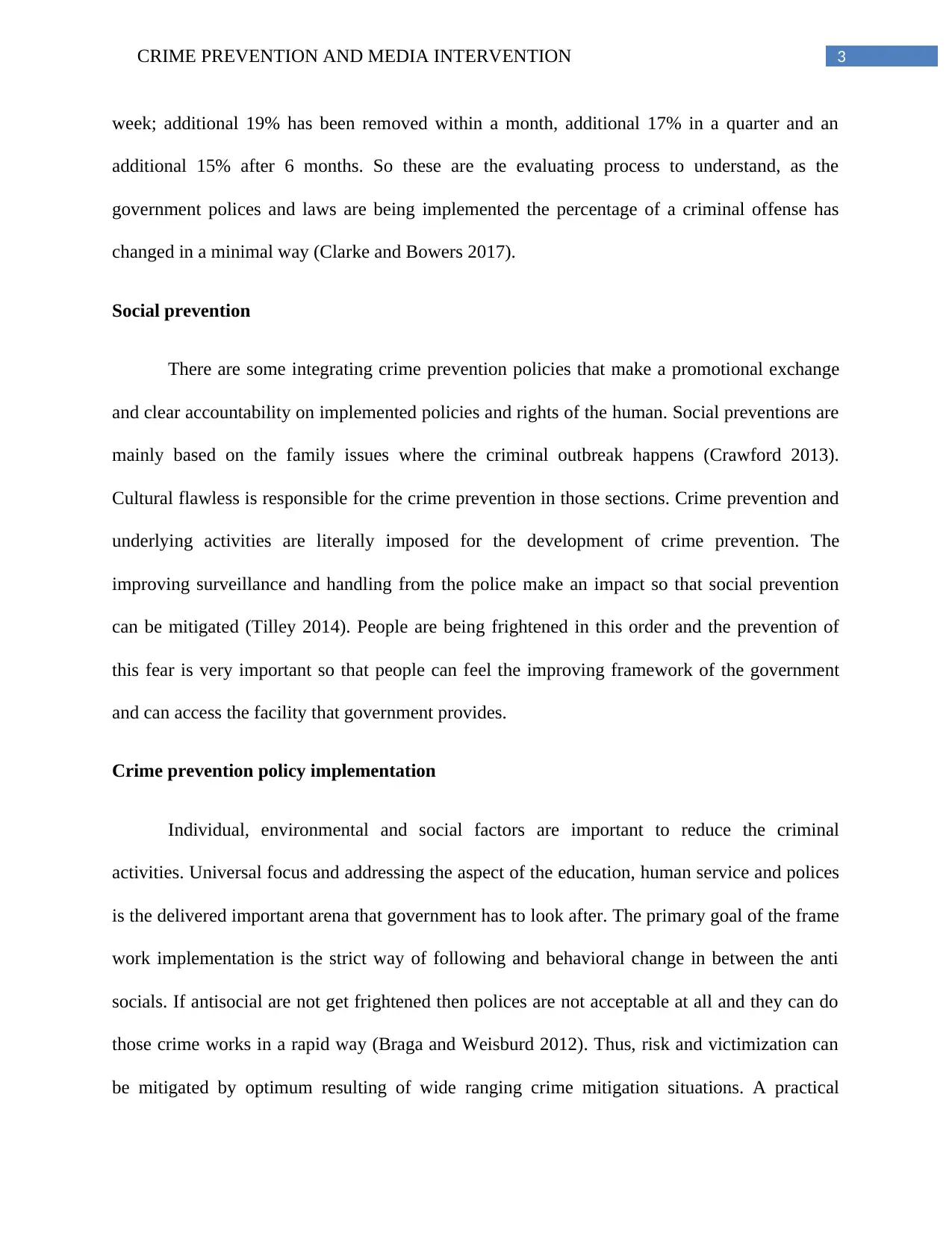
3CRIME PREVENTION AND MEDIA INTERVENTION
week; additional 19% has been removed within a month, additional 17% in a quarter and an
additional 15% after 6 months. So these are the evaluating process to understand, as the
government polices and laws are being implemented the percentage of a criminal offense has
changed in a minimal way (Clarke and Bowers 2017).
Social prevention
There are some integrating crime prevention policies that make a promotional exchange
and clear accountability on implemented policies and rights of the human. Social preventions are
mainly based on the family issues where the criminal outbreak happens (Crawford 2013).
Cultural flawless is responsible for the crime prevention in those sections. Crime prevention and
underlying activities are literally imposed for the development of crime prevention. The
improving surveillance and handling from the police make an impact so that social prevention
can be mitigated (Tilley 2014). People are being frightened in this order and the prevention of
this fear is very important so that people can feel the improving framework of the government
and can access the facility that government provides.
Crime prevention policy implementation
Individual, environmental and social factors are important to reduce the criminal
activities. Universal focus and addressing the aspect of the education, human service and polices
is the delivered important arena that government has to look after. The primary goal of the frame
work implementation is the strict way of following and behavioral change in between the anti
socials. If antisocial are not get frightened then polices are not acceptable at all and they can do
those crime works in a rapid way (Braga and Weisburd 2012). Thus, risk and victimization can
be mitigated by optimum resulting of wide ranging crime mitigation situations. A practical
week; additional 19% has been removed within a month, additional 17% in a quarter and an
additional 15% after 6 months. So these are the evaluating process to understand, as the
government polices and laws are being implemented the percentage of a criminal offense has
changed in a minimal way (Clarke and Bowers 2017).
Social prevention
There are some integrating crime prevention policies that make a promotional exchange
and clear accountability on implemented policies and rights of the human. Social preventions are
mainly based on the family issues where the criminal outbreak happens (Crawford 2013).
Cultural flawless is responsible for the crime prevention in those sections. Crime prevention and
underlying activities are literally imposed for the development of crime prevention. The
improving surveillance and handling from the police make an impact so that social prevention
can be mitigated (Tilley 2014). People are being frightened in this order and the prevention of
this fear is very important so that people can feel the improving framework of the government
and can access the facility that government provides.
Crime prevention policy implementation
Individual, environmental and social factors are important to reduce the criminal
activities. Universal focus and addressing the aspect of the education, human service and polices
is the delivered important arena that government has to look after. The primary goal of the frame
work implementation is the strict way of following and behavioral change in between the anti
socials. If antisocial are not get frightened then polices are not acceptable at all and they can do
those crime works in a rapid way (Braga and Weisburd 2012). Thus, risk and victimization can
be mitigated by optimum resulting of wide ranging crime mitigation situations. A practical
Paraphrase This Document
Need a fresh take? Get an instant paraphrase of this document with our AI Paraphraser
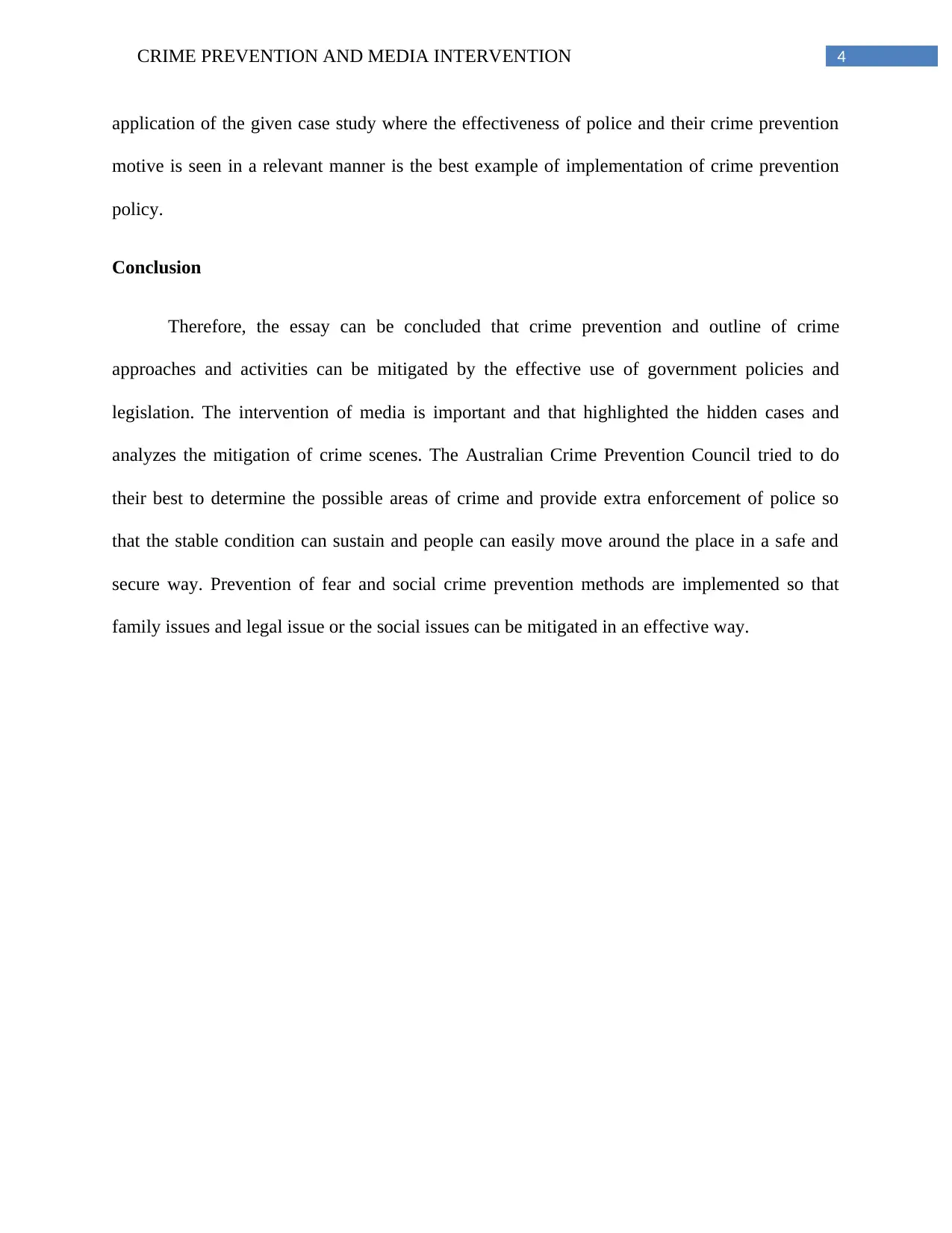
4CRIME PREVENTION AND MEDIA INTERVENTION
application of the given case study where the effectiveness of police and their crime prevention
motive is seen in a relevant manner is the best example of implementation of crime prevention
policy.
Conclusion
Therefore, the essay can be concluded that crime prevention and outline of crime
approaches and activities can be mitigated by the effective use of government policies and
legislation. The intervention of media is important and that highlighted the hidden cases and
analyzes the mitigation of crime scenes. The Australian Crime Prevention Council tried to do
their best to determine the possible areas of crime and provide extra enforcement of police so
that the stable condition can sustain and people can easily move around the place in a safe and
secure way. Prevention of fear and social crime prevention methods are implemented so that
family issues and legal issue or the social issues can be mitigated in an effective way.
application of the given case study where the effectiveness of police and their crime prevention
motive is seen in a relevant manner is the best example of implementation of crime prevention
policy.
Conclusion
Therefore, the essay can be concluded that crime prevention and outline of crime
approaches and activities can be mitigated by the effective use of government policies and
legislation. The intervention of media is important and that highlighted the hidden cases and
analyzes the mitigation of crime scenes. The Australian Crime Prevention Council tried to do
their best to determine the possible areas of crime and provide extra enforcement of police so
that the stable condition can sustain and people can easily move around the place in a safe and
secure way. Prevention of fear and social crime prevention methods are implemented so that
family issues and legal issue or the social issues can be mitigated in an effective way.
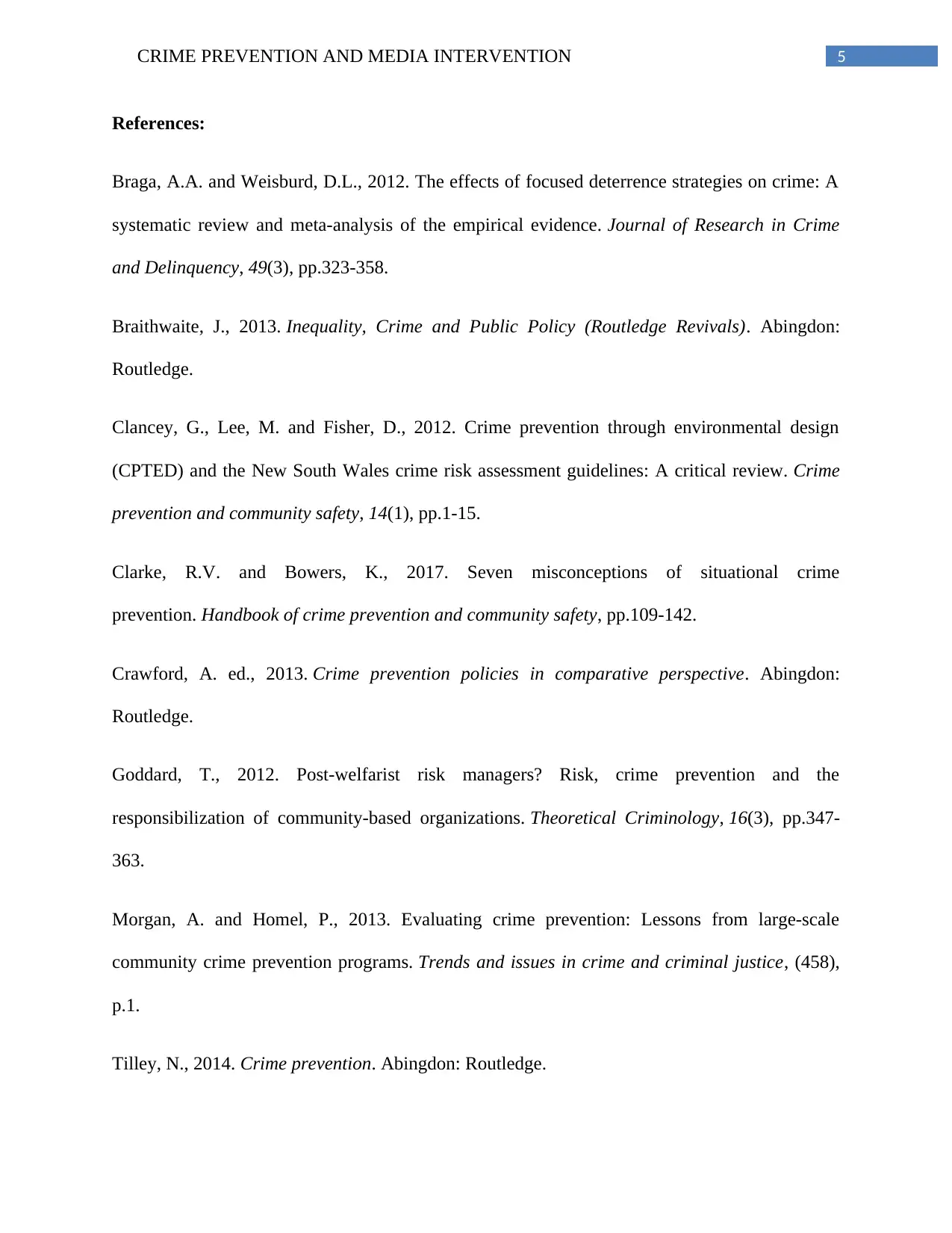
5CRIME PREVENTION AND MEDIA INTERVENTION
References:
Braga, A.A. and Weisburd, D.L., 2012. The effects of focused deterrence strategies on crime: A
systematic review and meta-analysis of the empirical evidence. Journal of Research in Crime
and Delinquency, 49(3), pp.323-358.
Braithwaite, J., 2013. Inequality, Crime and Public Policy (Routledge Revivals). Abingdon:
Routledge.
Clancey, G., Lee, M. and Fisher, D., 2012. Crime prevention through environmental design
(CPTED) and the New South Wales crime risk assessment guidelines: A critical review. Crime
prevention and community safety, 14(1), pp.1-15.
Clarke, R.V. and Bowers, K., 2017. Seven misconceptions of situational crime
prevention. Handbook of crime prevention and community safety, pp.109-142.
Crawford, A. ed., 2013. Crime prevention policies in comparative perspective. Abingdon:
Routledge.
Goddard, T., 2012. Post-welfarist risk managers? Risk, crime prevention and the
responsibilization of community-based organizations. Theoretical Criminology, 16(3), pp.347-
363.
Morgan, A. and Homel, P., 2013. Evaluating crime prevention: Lessons from large-scale
community crime prevention programs. Trends and issues in crime and criminal justice, (458),
p.1.
Tilley, N., 2014. Crime prevention. Abingdon: Routledge.
References:
Braga, A.A. and Weisburd, D.L., 2012. The effects of focused deterrence strategies on crime: A
systematic review and meta-analysis of the empirical evidence. Journal of Research in Crime
and Delinquency, 49(3), pp.323-358.
Braithwaite, J., 2013. Inequality, Crime and Public Policy (Routledge Revivals). Abingdon:
Routledge.
Clancey, G., Lee, M. and Fisher, D., 2012. Crime prevention through environmental design
(CPTED) and the New South Wales crime risk assessment guidelines: A critical review. Crime
prevention and community safety, 14(1), pp.1-15.
Clarke, R.V. and Bowers, K., 2017. Seven misconceptions of situational crime
prevention. Handbook of crime prevention and community safety, pp.109-142.
Crawford, A. ed., 2013. Crime prevention policies in comparative perspective. Abingdon:
Routledge.
Goddard, T., 2012. Post-welfarist risk managers? Risk, crime prevention and the
responsibilization of community-based organizations. Theoretical Criminology, 16(3), pp.347-
363.
Morgan, A. and Homel, P., 2013. Evaluating crime prevention: Lessons from large-scale
community crime prevention programs. Trends and issues in crime and criminal justice, (458),
p.1.
Tilley, N., 2014. Crime prevention. Abingdon: Routledge.
⊘ This is a preview!⊘
Do you want full access?
Subscribe today to unlock all pages.

Trusted by 1+ million students worldwide

6CRIME PREVENTION AND MEDIA INTERVENTION
1 out of 7
Related Documents
Your All-in-One AI-Powered Toolkit for Academic Success.
+13062052269
info@desklib.com
Available 24*7 on WhatsApp / Email
![[object Object]](/_next/static/media/star-bottom.7253800d.svg)
Unlock your academic potential
Copyright © 2020–2025 A2Z Services. All Rights Reserved. Developed and managed by ZUCOL.





